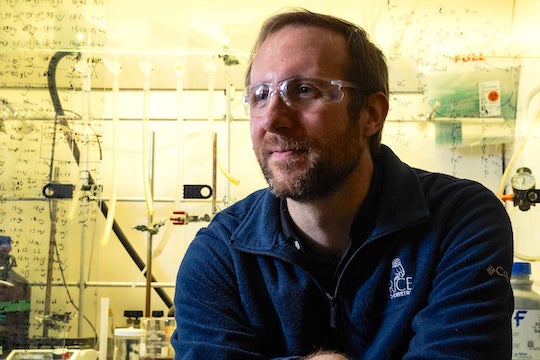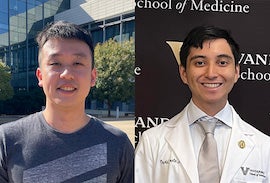by Carlyn Chatfield
Special to Rice News

(Photo by Jeff Fitlow/Rice University)
When it comes to chemical reactions, fluorine has a reputation as a ‘magic bullet atom’ for its ability to increase a drug’s absorption and prolong its lifetime. However, traditional methods of adding it to compounds entail expensive materials and can be difficult to pull off.
Rice University scientists developed a reliable and cost-effective process of adding fluorine to molecules for increased pharmaceutical drug efficiency using an iron and sulfur reaction. According to a study published in Nature Chemistry, the light-activated reaction can be used both to free up fluorine from carboxylic acids and to incorporate it into alkenes ⎯ common building blocks for pharmaceuticals and other chemical products. The chemical pathway developed by Rice researchers spells a new formula for easier, cheaper and more effective fluorination.
“The secret for many important drugs, from Prozac to Lipitor, is an atom called fluorine,” said Julian West, the Norman Hackerman-Welch Young Investigator and assistant professor of chemistry. “When attached to drug molecules, this little atom can make the treatments act faster for longer and with fewer side effects. But it’s hard to attach fluorine when making drugs. Existing processes often require chemicals that are very expensive, dangerously reactive and that just don’t work very well.”

The West research group wondered if it could find a way to add fluorine to molecules through a cheap, efficient, safe process.
“This was a big, pie-in-the-sky idea when we started our research group in 2019, but we were feeling pretty confident we could do it after discovering that iron and sulfur can work together to create a kind of reaction called decarboxylation,” West said.
Unlike the noble metal starting materials used to synthesize molecules for a variety of industries, more common elements like iron and sulfur are easily accessed, inexpensive and abundant around the world. Earlier this year, the West research group found that when it shines light on iron and sulfur, they interact like rowdy bar patrons that erupt into a melee with enough energy to break apart carboxylic acid molecules, freeing up fluorine atoms for use elsewhere.
“Carboxylic acids are everywhere; they are cheap, available and hardy,” West said. “The problem is that their very stability makes them difficult to break into useful parts. If iron and sulfur could decarboxylate these common materials, making their fluorine atoms available, then we would be off to the races.”

Once the researchers determined how to free up the fluorine from these stable compounds, they next had to figure out how to reattach it in an effective and safe manner. Rice doctoral alum Yen-Chu Lu and chemistry graduate student Kang-Jie (Harry) Bian figured out that fluorinated carboxylic acids could react with alkenes, another common part of drug molecules.
“Alkenes are most commonly used to help put the drugs together because they can be transformed into many different things, like a foundation that more complex parts can be built on,” West said. “Yen-Chu and Harry determined the same iron and sulfur combination that cracked the carboxylic acid could facilitate attachment of the newly revealed fluorine fragment to alkenes.”
Not only is the new strategy fast, simple and safe, but it also seems applicable in a wide variety of uses.

(Photos courtesy of Yen-Chu Lu and David Nemoto)
“If you want to add a different fluorine piece, just put in a different carboxylic acid,” West said.
Lu and Bian worked with Rice graduate student Shih-Chieh Kao and undergraduates Xiaowei Chen and David Nemoto Jr. to stress-test the strategy.
“They really pushed this approach to its limits and haven’t yet discovered its boundaries,” West said. “The team did an amazing job, and I’m super lucky to have such creative coworkers in our group.”
The research was supported by the Cancer Prevention and Research Institute of Texas (RR19025), the National Institutes of Health (R35GM142738) and the Welch Foundation (C-2085).
- Peer-reviewed paper:
-
“Photocatalytic Hydrofluoroalkylation of Alkenes with Carboxylic Acids” | Nature Chemistry | DOI: 10.1038/s41557-023-01365-0
Authors: Kang-Jie Bian, Yen-Chu Lu, David Nemoto Jr., Shih-Chieh Kao, Xiao-Wei Chen and Julian G. West - Image downloads:
-
https://news-network.rice.edu/news/files/2023/11/231030_ROCC_Fitlow_012.jpg
CAPTION: Julian West (from left), Kang-Jie (Harry) Bian, Xiaowei Chen and Shih-Chieh Kao
(Photo by Jeff Fitlow/Rice University)https://news-network.rice.edu/news/files/2023/11/231030_ROCC_Fitlow_018.jpg
CAPTION: Researchers in the West laboratory perform a chemical reaction using iron and sulfur photocatalysis. (Photo by Jeff Fitlow/Rice University)
https://news-network.rice.edu/news/files/2023/11/231030_ROCC_Fitlow_008.jpg
CAPTION: View inside a chemical fume hood in the West laboratory. (Photo by Jeff Fitlow/Rice University)https://news-network.rice.edu/news/files/2023/11/231030_ROCC_Fitlow_002.jpg
CAPTION: Julian West is Rice’s Norman Hackerman-Welch Young Investigator, an assistant professor of chemistry and a Cancer Prevention and Research Institute of Texas scholar. (Photo by Jeff Fitlow/Rice University)https://news-network.rice.edu/news/files/2023/11/Lu_Nemoto.jpg
CAPTION: Yen-Chu Lu (left) and David Nemoto
(Photos courtesy of Yen-Chu Lu and David Nemoto)
- Related stories:
-
Rice U. lab develops sustainable chemical synthesis tool:
https://news.rice.edu/news/2023/lab-notes-april-17-2023Lab lights way to simple chemical synthesis:
https://news.rice.edu/news/2023/lab-lights-way-simple-chemical-synthesisProcess to customize molecules does double-duty:
https://news.rice.edu/news/2022/process-customize-molecules-does-double-duty - Links:
-
West research group: https://www.westchem.org/
Department of Chemistry: https://chemistry.rice.edu/
Wiess School of Natural Sciences: https://naturalsciences.rice.edu/
- About Rice:
-
Located on a 300-acre forested campus in Houston, Rice University is consistently ranked among the nation’s top 20 universities by U.S. News & World Report. Rice has highly respected schools of architecture, business, continuing studies, engineering, humanities, music, natural sciences and social sciences and is home to the Baker Institute for Public Policy. With 4,574 undergraduates and 3,982 graduate students, Rice’s undergraduate student-to-faculty ratio is just under 6-to-1. Its residential college system builds close-knit communities and lifelong friendships, just one reason why Rice is ranked No. 1 for lots of race/class interaction, No. 2 for best-run colleges and No. 12 for quality of life by the Princeton Review. Rice is also rated as a best value among private universities by Kiplinger’s Personal Finance.

